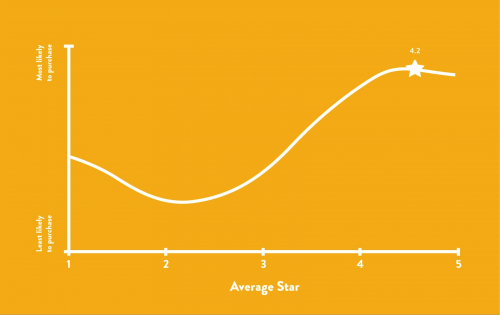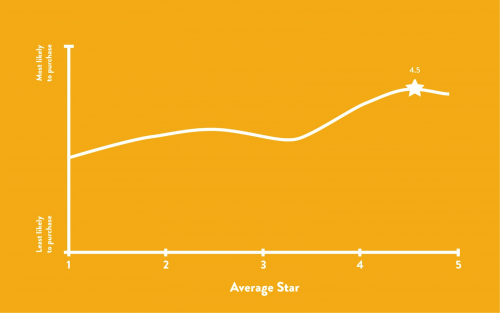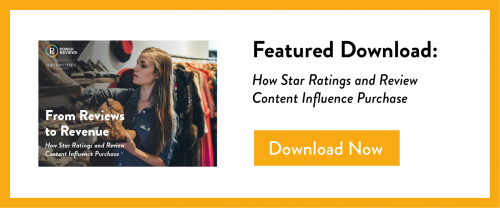Study explores how specific features of ratings and reviews, such as length and sentiment, impact probability of purchase.
SEPTEMBER 22, 2015 – CHICAGO – An increasingly influential part of the consumer purchase process, ratings and reviews impact purchase decisions more than any other factor except price. Yet despite all of the research on the power of reviews, the circumstances that guide when and how ratings and reviews are most effective at driving sales is still a largely unexplored topic.
PowerReviews, a leading provider of ratings, reviews and question-and-answer technology to more than 1,000 brands and retailers, worked with Northwestern University’s Medill IMC Spiegel Digital & Database Research Center to release, “From Reviews to Revenue: How Star Ratings and Review Content Influence Purchase,” an analysis of how ratings and reviews influence purchase probability. Using PowerReviews data, Northwestern analyzed the impact of review length, sentiment and star ratings within the fast moving consumer goods (FMCG) category.
“We’re always seeking new information to help our customers – brands and retailers – understand the best ways to employ user-generated content to drive traffic and sales,” said Matt Moog, CEO of PowerReviews. “We’re excited to partner with Northwestern University and the Spiegel Research Center to deepen our understanding of the consumer purchase process through this third-party analysis.”
“While previous research has established that ratings and reviews are influential in purchase decisions, we set out to investigate the circumstances under which they are most influential,” said Tom Collinger, executive director of the Spiegel Research Center. “In our analysis, we found that not only are five star reviews not ideal for today’s skeptical shoppers, but that ratings and reviews carry more weight for items that require a higher level of consideration.”
Among the findings of the study, PowerReviews and Northwestern discovered three key insights:
Too Good To Be True: The Power of Negative Reviews
Contrary to popular belief, the presence of some negative reviews can actually help boost sales. According to Northwestern’s findings, the likelihood of purchase peaks for products with an overall average star rating between 4.2 and 4.5. Products with five-star ratings are, in the eyes of the consumer, too good to be true.
Shoppers understand that every item can’t be the newest, fastest, cheapest and highest quality and often look at perfect five-star reviews with a level of skepticism. While brands and retailers should never aim for negative reviews, it is imperative that they embrace them. The presence of negative reviews builds trust with shoppers and makes overall product review data more credible.
Importance of Star Ratings for High Consideration Items
Northwestern found that when consumers evaluate items that require a higher level of consideration, an item’s star rating has a much stronger impact. Higher consideration purchases are defined as those that pose some type of risk – whether due to expense, safety implication or unfamiliarity with the product or brand. Shoppers look to additional information – such as star ratings and reviews – to help mitigate that risk.
For example, a consumer may not ordinarily seek out reviews for everyday items such as cereal or shampoo, but if they’re considering a new brand or more expensive item within that category, it’s important that review and rating information is available. And if those products are highly rated, consumers are more likely to purchase than if they were not. As a result, reviews are an important resource to have when launching new products or brands.
When Reviews Are Shorter, More is Better
Traditionally, brands and retailers have been concerned with volume of reviews with the mindset that the more reviews, the better. However, Northwestern’s analysis found that the ideal number of reviews depends on the length of the reviews themselves. When reviews are shorter, shoppers prefer to read more reviews, but when reviews are longer and more diagnostic, fewer reviews is acceptable.
For more insights and to download the full report, visit www.powerreviews.com.
About PowerReviews
PowerReviews is the choice of more than 1,000 global brands and retailers to collect and display ratings and reviews on 5,000 websites. An essential resource for consumers as they search and shop online and in-store, ratings and reviews drive relevant traffic, increase sales, and create actionable insights to improve products and services. PowerReviews’ mobile-friendly rating and review and Q&A software is fast to implement and simple to customize, making it easy for brands and retailers to generate more authentic content that is seen by more consumers. The PowerReviews Open Network is the largest in the industry, more than 1 billion in-market shoppers every month, giving retailers and brands the power to reach shoppers wherever they are. For more information, visit www.powerreviews.com.
About Northwestern University’s Medill IMC Spiegel Digital & Database Research Center
The Medill IMC Spiegel Digital & Database Research Center is the first research center at the Medill School of Journalism, Media, Integrated Marketing Communications. It was founded in 2011 by a generous gift from the late Professor Emeritus Edward J. “Ted” Spiegel and his wife Audrey, and fortified by the support of corporations, alumni and friends. The center is part of Northwestern’s long tradition of applied research about advertising and marketing. The focus of the Spiegel Research Center is to do evidence-based, data driven analysis to prove the relationship between customer engagement and purchase behavior. The center’s research focuses on consumer behavior in social media and on mobile devices.
For additional information:
Meghan Spork
Walker Sands Communications
312-241-1474
Meghan.spork@walkersands.com





